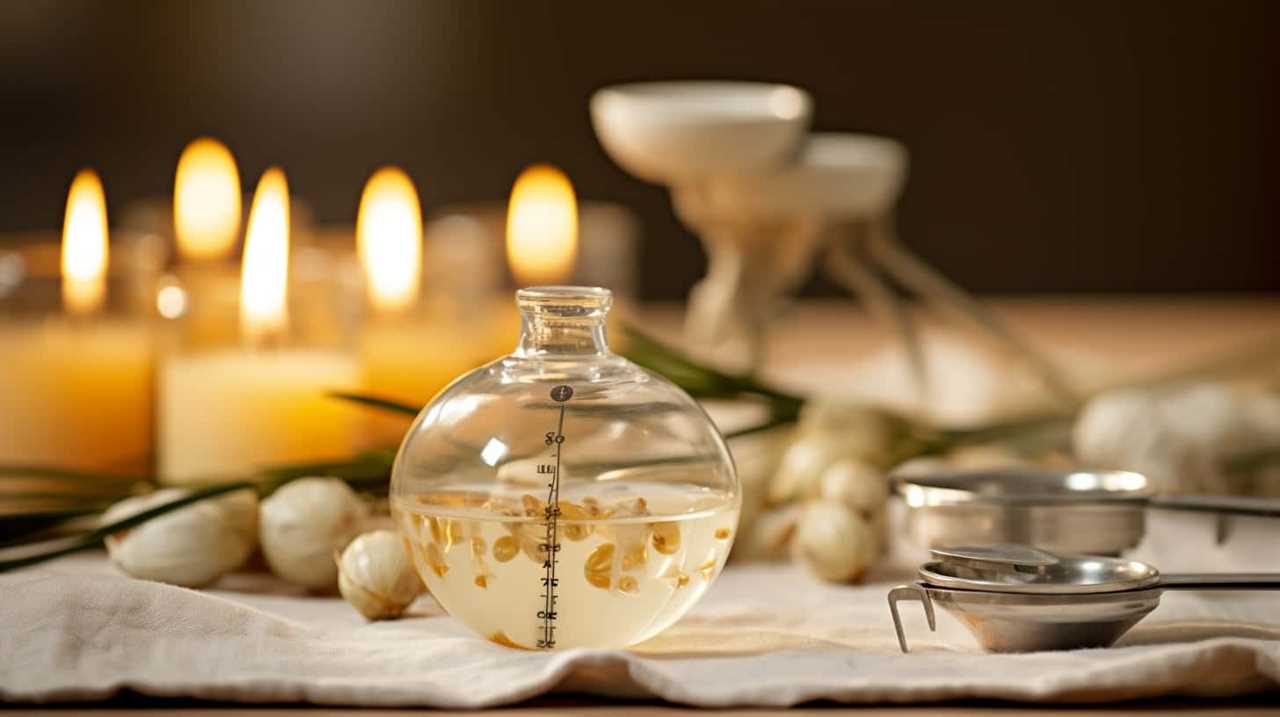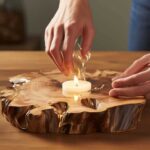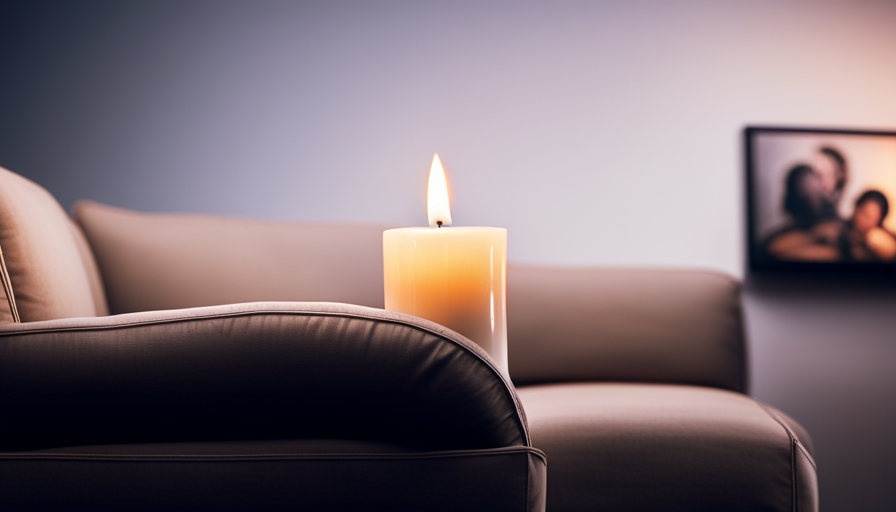Have you ever lit a candle and watched as it burned slowly, giving off a soft and constant flame?
Well, my friends, in this exploration, we shall delve into the intriguing question of what it means when a candle burns slow.
As we seek mastery in understanding this phenomenon, we shall uncover a world of scientific explanations and symbolic interpretations.
From the composition of the wax to the length and material of the wick, from the ambient temperature to the presence of drafts, various factors come into play.

We will also discover how the size and shape of the candle, as well as burn time and proper care, can influence its burning speed.
So, let us embark on this enlightening journey to unravel the secrets behind a candle’s slow burn.
Key Takeaways
- Slow burning candles indicate lower wax consumption and longer burning duration.
- Factors such as stable flame temperature, steady oxygen supply, and understanding flame behavior contribute to slow burning.
- The melting point of wax, wax composition, and additives can influence the burning speed of a candle.
- Environmental factors, such as ambient temperature and airflow, also affect the burn rate of candles.
Scientific Explanation
In our scientific explanation, we frequently observe that when a candle burns slowly, it indicates a lower rate of wax consumption and a longer duration of burning. This phenomenon can be attributed to the behavior of the candle flame and the combustion process.
When a candle burns slowly, it means that the flame is receiving a steady supply of oxygen, allowing for a more efficient and controlled combustion. The flame is able to maintain a stable temperature, resulting in a slower rate of wax vaporization.
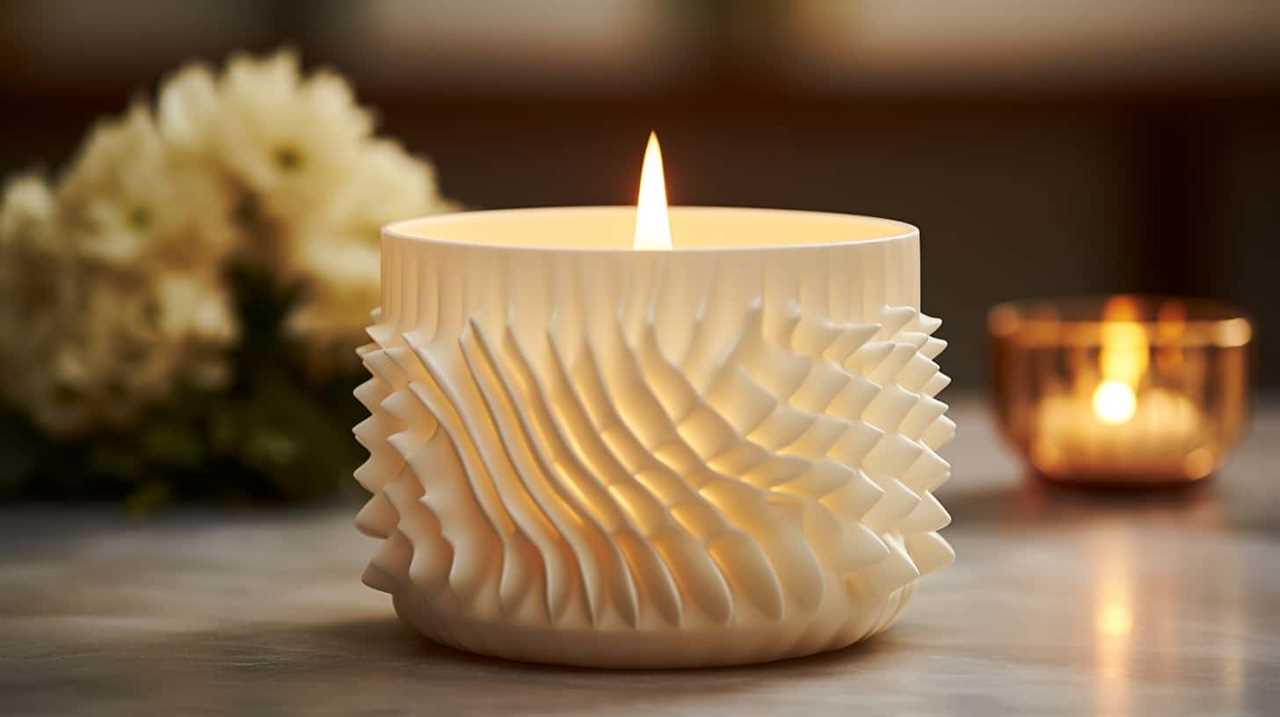
This slower rate of wax consumption leads to a longer duration of burning, as the candle gradually consumes the wax. Understanding the factors that influence candle flame behavior and the combustion process can help us better appreciate the science behind the slow burning of candles.
Wax Composition
When discussing the slow burning of candles, it’s essential to consider the wax composition. The melting point of the wax plays a significant role in determining the burning speed, with higher melting point waxes burning slower.
Additionally, the choice between soy and paraffin wax can also affect the burn time, as soy wax tends to burn slower than paraffin.
Lastly, the use of additives in the wax, such as stearic acid or vybar, can further impact the burn rate of the candle.
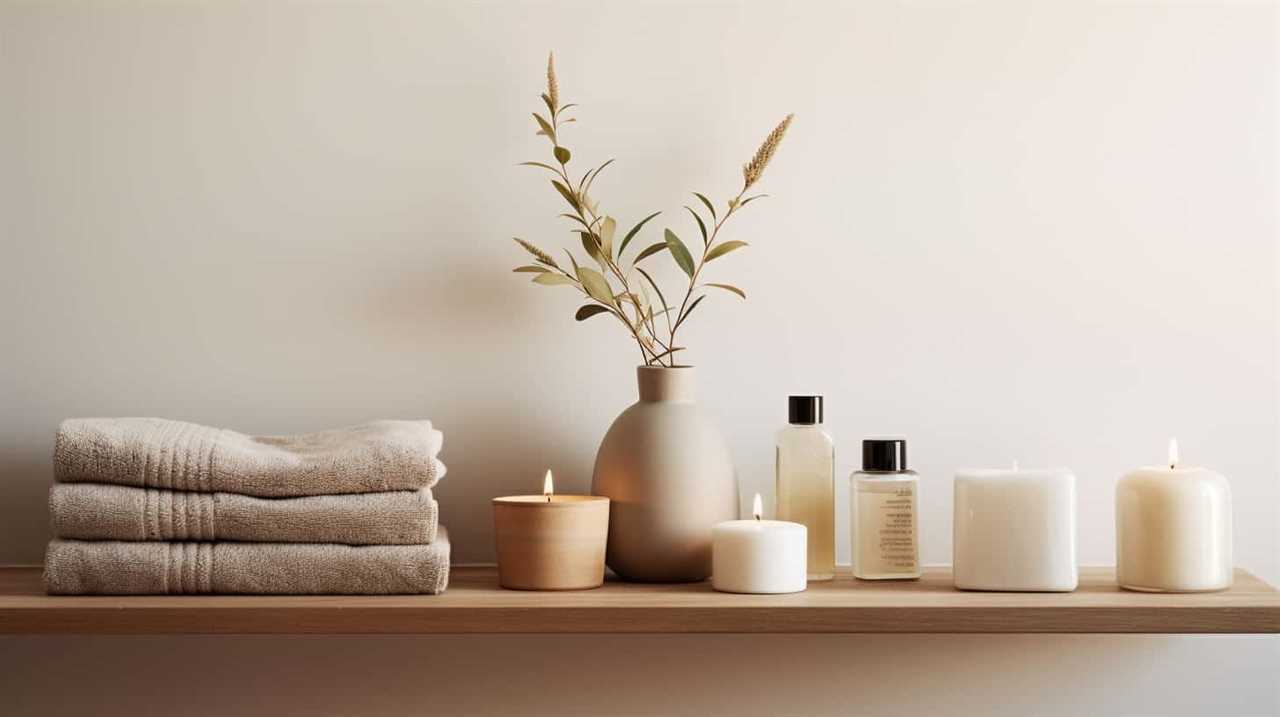
Candle Melting Point
Our observations regarding the slow burning of a candle lead us to explore the role of candle melting point and wax composition. The melting point of a candle affects its burning rate and can be influenced by various factors. Here are four key points to consider:
- Wax type: Different types of wax have different melting points. For example, soy wax has a lower melting point compared to paraffin wax. This difference in melting points can affect how quickly the candle burns.
- Additives: Certain additives, such as stearic acid or beeswax, can raise the melting point of the wax. This can result in a slower burning candle.
- Wick size: The wick size should be appropriate for the candle’s melting point. A wick that’s too small may not be able to keep up with the melting wax, leading to a slower burn.
- Container material: The material of the candle container can also impact the melting point. Materials like glass retain heat better, causing the wax to melt slower and the candle to burn at a slower rate.
Understanding the role of candle melting point and wax composition can help us better understand and control the burning rate of candles.
Soy Vs. Paraffin
The role of wax composition in candle burning rate can be further understood by comparing soy wax and paraffin wax.
Soy wax is a natural alternative to paraffin wax, which is derived from petroleum. Soy wax is made from soybean oil, making it a renewable and environmentally friendly option. It has a lower melting point than paraffin wax, which means it burns at a slower rate. Additionally, soy wax has a cleaner burn with less soot and smoke compared to paraffin wax.
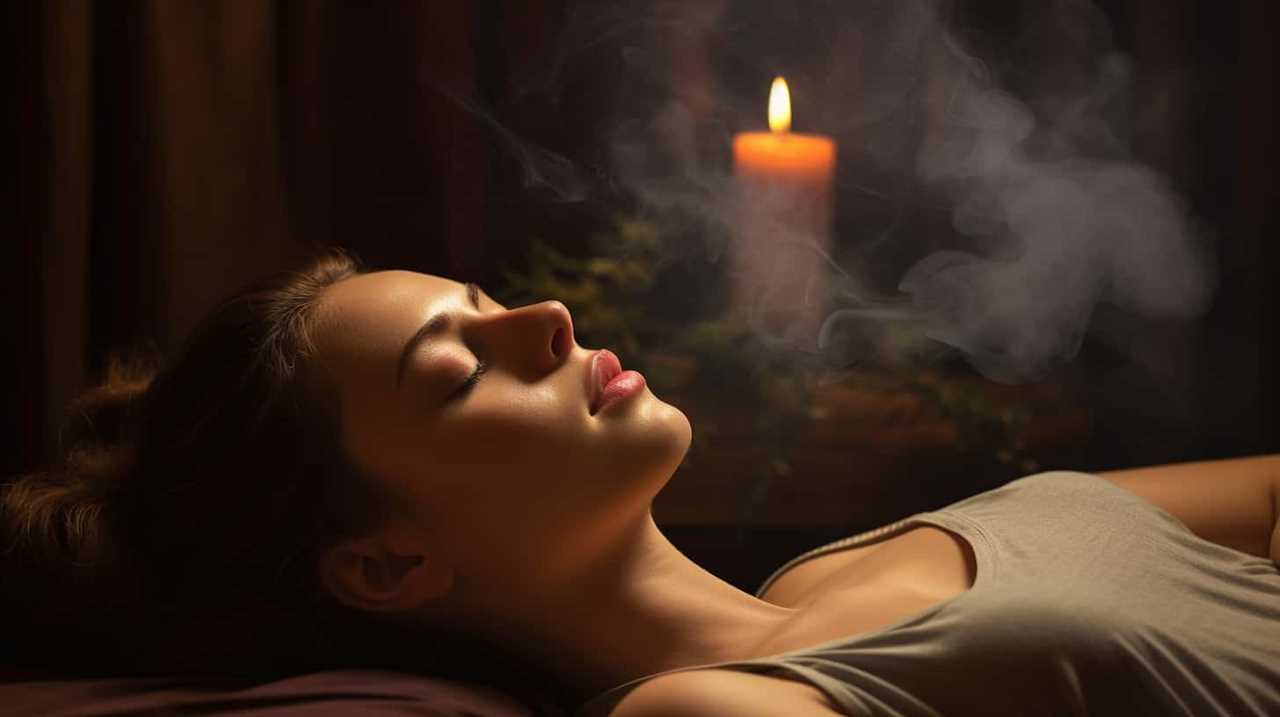
Another advantage of soy wax is that it has a better ability to hold fragrance, resulting in a stronger and longer-lasting scent. In contrast, paraffin wax tends to release more volatile organic compounds, which can have negative health and environmental impacts.
Therefore, choosing soy wax over paraffin wax can provide a cleaner and more sustainable candle-burning experience.
Impact of Additives
Adding certain additives to the wax composition of a candle can significantly affect its burning rate. There are several factors to consider when it comes to candle additives and their impact on the burning rate:
- Type of additive: Different additives, such as stearic acid or beeswax, can be incorporated into the wax to modify the burning characteristics. These additives can increase the melting point of the wax, resulting in a slower burning rate.
- Concentration of additives: The amount of additives used in the wax mixture can also influence the burning rate. Higher concentrations of additives can lead to a slower and more controlled burn.
- Wick compatibility: The choice of additives should be compatible with the wick material. Some additives may require a larger or different type of wick to achieve optimal burning performance.
- Environmental factors: The burning rate of a candle can also be influenced by external factors such as room temperature and airflow. Additives that enhance the stability of the wax can help maintain a consistent burning rate even in varying conditions.
Understanding the impact of candle additives on the burning rate can help candle makers create candles with desired burning characteristics.
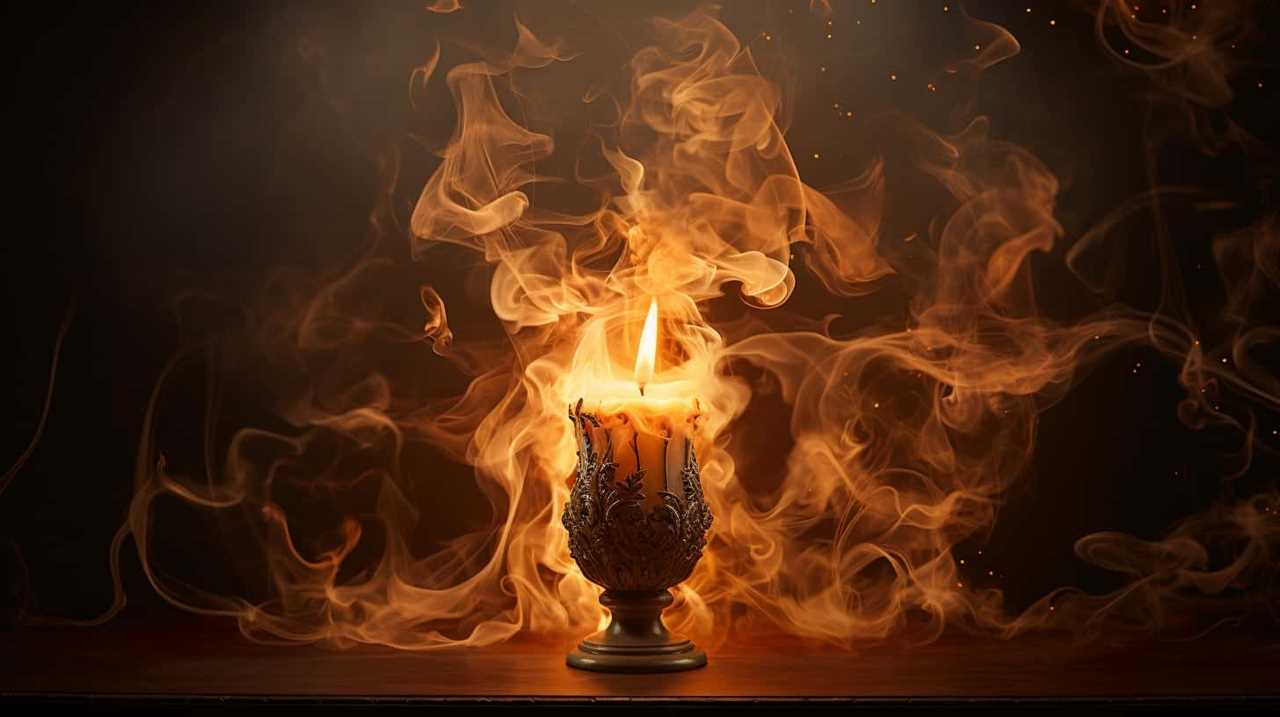
Wick Length and Material
When it comes to the length and material of a candle wick, there are a few key points to consider. First, the optimal wick length plays a crucial role in how a candle burns. If the wick is too short, it may struggle to draw up enough wax to fuel a steady flame. On the other hand, if the wick is too long, it can lead to a larger flame and faster burning.
Additionally, the material of the wick can also affect the burn rate and overall performance of the candle. Some common materials include cotton, paper, and hemp, each with their own characteristics and burn qualities.
Optimal Wick Length
For optimal candle burning, it’s important to consider the length and material of the wick. The wick plays a crucial role in determining the quality of the flame and the overall performance of the candle. Here are four key factors to consider when determining the optimal wick length:
- Wick length should be determined based on the size of the candle. A shorter wick is ideal for smaller candles, while larger candles require a longer wick to ensure an optimal flame.
- The wick material should be carefully chosen. Cotton wicks are commonly used as they burn consistently and produce a steady flame. However, alternative materials like wood or hemp can also be used depending on the desired effect.
- Regular wick maintenance is essential for optimal burning. Trimming the wick to a quarter-inch before each use helps prevent excessive smoking and ensures a clean, even burn.
- Experimentation may be necessary to find the perfect wick length for a specific candle. Factors such as wax type, fragrance load, and container size can all impact the performance of the wick.
Wick Material Effects
To understand the effects of wick material on candle burning, we must consider its impact on both wick length and material.
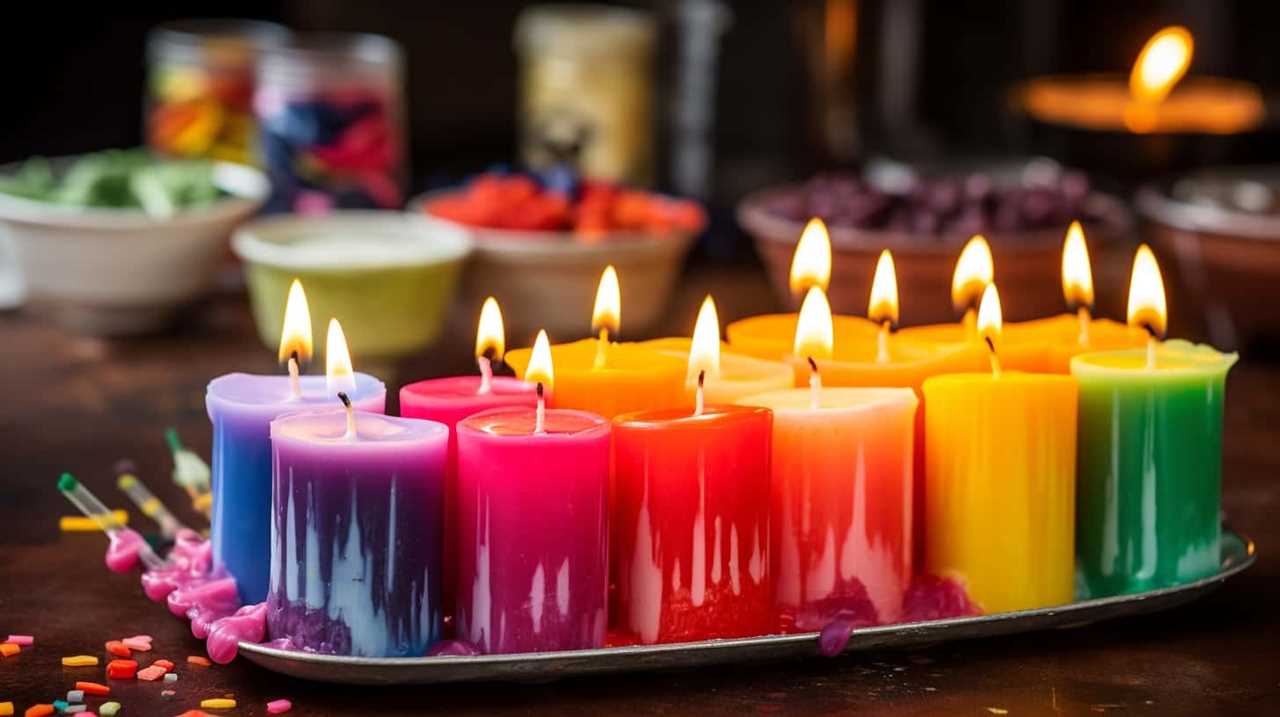
The choice of wick material can significantly affect the performance of the wick and the intensity of the flame. Different wick materials have varying levels of absorbency and burn rate. For example, cotton wicks tend to have a slower burn rate compared to other materials like hemp or paper. This slower burn rate can result in a longer-lasting candle.
On the other hand, wicks made from materials like hemp or paper may have a higher absorbency, allowing the wax to be drawn up more effectively and producing a more intense flame. Therefore, the choice of wick material is crucial in determining the overall performance of a candle and the intensity of the flame it produces.
Ambient Temperature
Our experience has shown that the ambient temperature greatly affects the rate at which candles burn. Here are four key ways in which the ambient temperature influences candle burning and flame behavior:
- Heat transfer: Higher ambient temperatures facilitate faster heat transfer from the flame to the surrounding environment. This can lead to more efficient combustion and a faster burn rate.
- Wax melting point: Different candle waxes have varying melting points. In warmer ambient temperatures, candles with lower melting points may soften or even melt, causing them to burn faster.
- Air circulation: The movement of air in the environment can affect the behavior of the candle flame. In drafty areas or with strong air currents, the flame may flicker and burn unevenly.
- Oxygen supply: The ambient temperature can influence the availability of oxygen for combustion. In colder temperatures, the density of air increases, potentially leading to a more robust flame.
Understanding the impact of ambient temperature on candle burning and flame behavior allows us to better control and optimize our candle burning experiences.
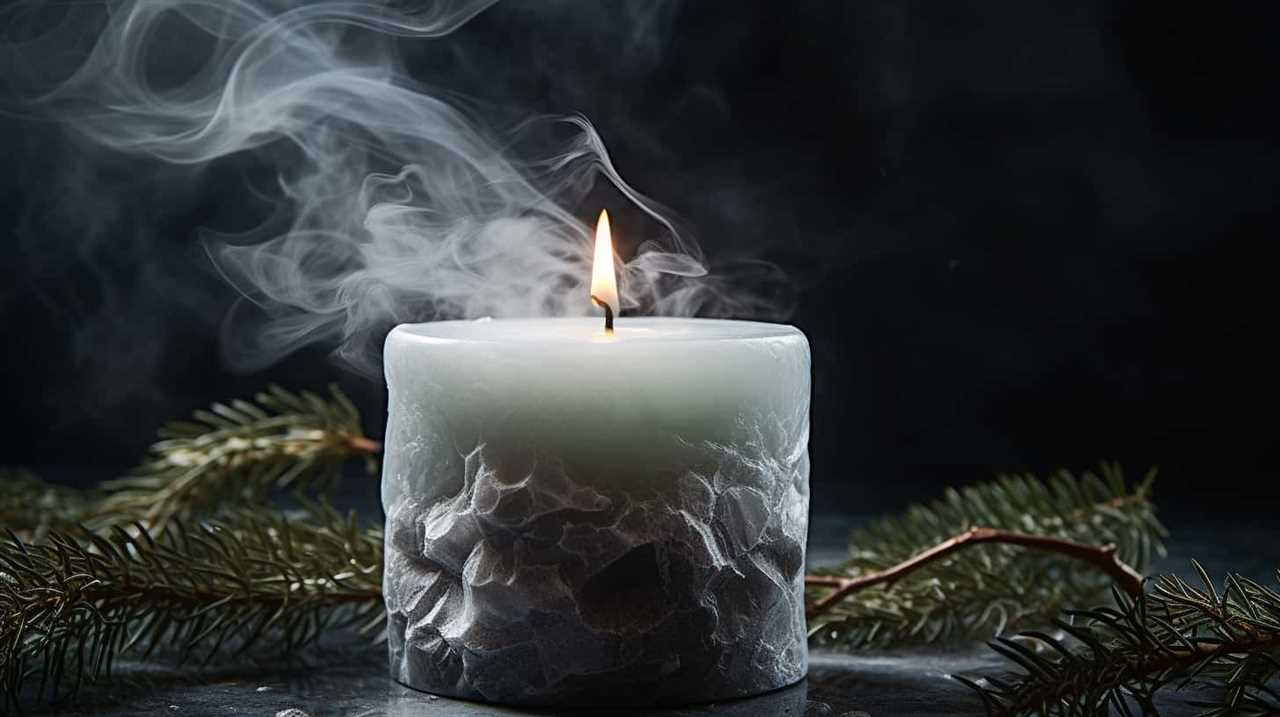
Airflow and Drafts
In our experience, a noticeable decrease in airflow around a candle often results in a significantly slower burn rate. Airflow plays a crucial role in the combustion process of a candle. When there’s limited airflow or the presence of drafts, the flame is deprived of the oxygen it needs for efficient burning. This leads to a reduction in the candle’s burn rate.
Additionally, airflow can affect the air quality around the candle. If the air quality is poor, it can interfere with the fragrance of the candle, making it less pronounced or even unpleasant. Therefore, it’s important to ensure that there’s adequate ventilation in the room where the candle is placed to maintain a steady burn rate and enhance the overall candle experience.
Moving on to the next section, let’s explore how candle size and shape can impact burn time.
Candle Size and Shape
Continuing from the previous subtopic, we often find that the size and shape of a candle directly influence its burn time. Here are four key factors to consider regarding candle size and shape:

- Candle Fragrance: Scented candles tend to burn slightly faster than unscented ones due to the added fragrance oils. The intensity of the fragrance can also impact burn time.
- Candle Coloration: The color of a candle can affect its burn time as well. Darker colored candles, such as those with deep pigments, tend to burn faster than lighter colored ones.
- Candle Diameter: Generally, candles with larger diameters burn slower than their narrower counterparts. This is because a larger surface area allows for a more even distribution of heat, resulting in a slower burn.
- Candle Height: Taller candles tend to have longer burn times compared to shorter ones. This is because taller candles have more wax to burn through.
Understanding how candle size and shape can impact burn time is crucial for maximizing your candle experience.
Transitioning into the subsequent section about ‘burn time and candle care’, let’s delve deeper into the factors that can affect how long a candle lasts.
Burn Time and Candle Care
Maximizing the burn time and caring for your candle involves proper maintenance and attentive monitoring. Candle safety is of utmost importance to ensure a long-lasting and enjoyable experience. By following a few simple tips, you can enhance the burn time of your candles and create a safe environment for their use.
To help you understand the factors that affect burn time and ensure optimal candle care, here is a table outlining some key considerations:
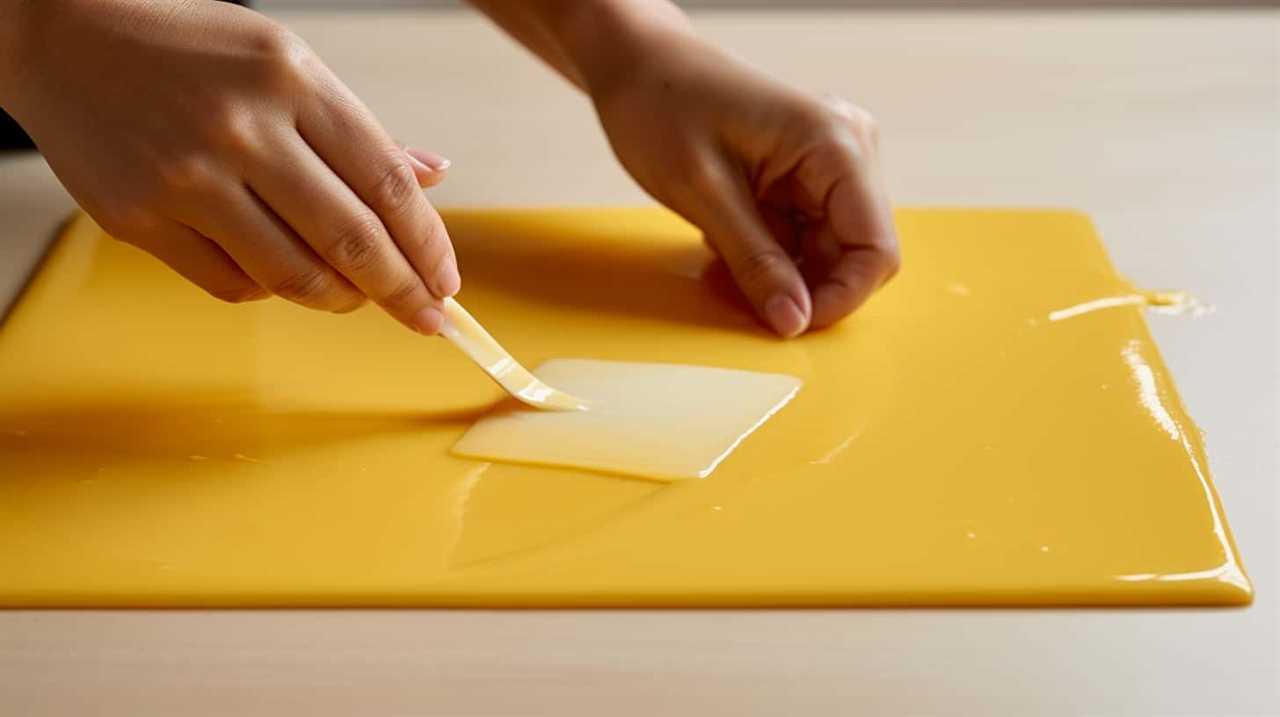
| Factors Affecting Burn Time | Candle Care Tips |
|---|---|
| Quality of Wax | Trim the wick before each use to 1/4 inch to prevent excessive smoking and ensure an even burn. |
| Candle Size | Place candles in a draft-free area to prevent uneven burning and excessive sooting. |
| Ambient Temperature | Keep candles away from direct sunlight and heat sources to avoid melting and shorten burn time. |
| Burning Time | Avoid burning candles for more than 4 hours at a time to prevent overheating and reduce the risk of accidents. |
Symbolic Interpretations
When candles burn slowly, their symbolic interpretations can provide insight into the energy and emotions surrounding a situation. The symbolic meanings associated with a candle’s burn rate have cultural significance and can vary across different traditions and beliefs. Here are four possible interpretations of a slow-burning candle:
- Patience and endurance: A candle that burns slowly may represent the need for patience in a particular situation. It symbolizes the importance of staying steadfast and enduring challenges until the desired outcome is achieved.
- Intense emotions: Slow-burning candles can also indicate heightened emotions and deep emotional connections. It suggests that the energy and passion surrounding the situation are intense and require careful handling.
- Deliberate progress: In some cultures, a slow-burning candle is seen as a sign of deliberate progress. It signifies the importance of taking slow and steady steps towards achieving goals rather than rushing into things.
- Spiritual presence: In certain spiritual practices, a candle burning slowly can be interpreted as the presence of a spiritual entity. It signifies their guidance and support in navigating through difficult times.
Understanding the symbolic interpretations of a slow-burning candle can help us gain a deeper understanding of the underlying emotions and energies at play in a given situation. It allows us to approach the situation with mindfulness and make informed decisions.
Conclusion and Final Thoughts
So, what can we take away from the symbolic interpretations of a slow-burning candle?
The symbolic meanings associated with a slow-burning candle can vary depending on the context and individual beliefs. However, it’s generally seen as a sign of patience, endurance, and perseverance. When a candle burns slowly, it suggests that the energy or intention behind it’s strong and steady. It encourages us to have patience and trust in the process, even when things seem to be moving slowly.

Factors affecting burn time include the type and quality of the candle, the environment it’s placed in, and the presence of any drafts or air currents. Understanding these factors can help us interpret the symbolism behind a slow-burning candle and apply it to our own lives.
Frequently Asked Questions
Can Burning a Candle for an Extended Period of Time Cause Any Health Hazards?
Burning a candle for an extended period of time can potentially cause respiratory effects and pose fire hazards. It is important to take fire safety precautions, such as never leaving a burning candle unattended and ensuring proper ventilation in the room.
Is It Possible for a Candle to Burn Slower if It Is Placed in a Specific Location in a Room?
When a candle burns slow, its placement in a room can indeed affect its burning rate. Factors like air circulation, proximity to drafts, and temperature can all contribute to the candle’s slower burn.
Are Scented Candles More Likely to Burn Slower Than Unscented Ones?
Scented candles may burn slower than unscented ones due to the additional fragrance oils present. However, the size of the wick can also impact burn rate. Both factors should be considered when analyzing the effect of fragrance on candle burning speed.
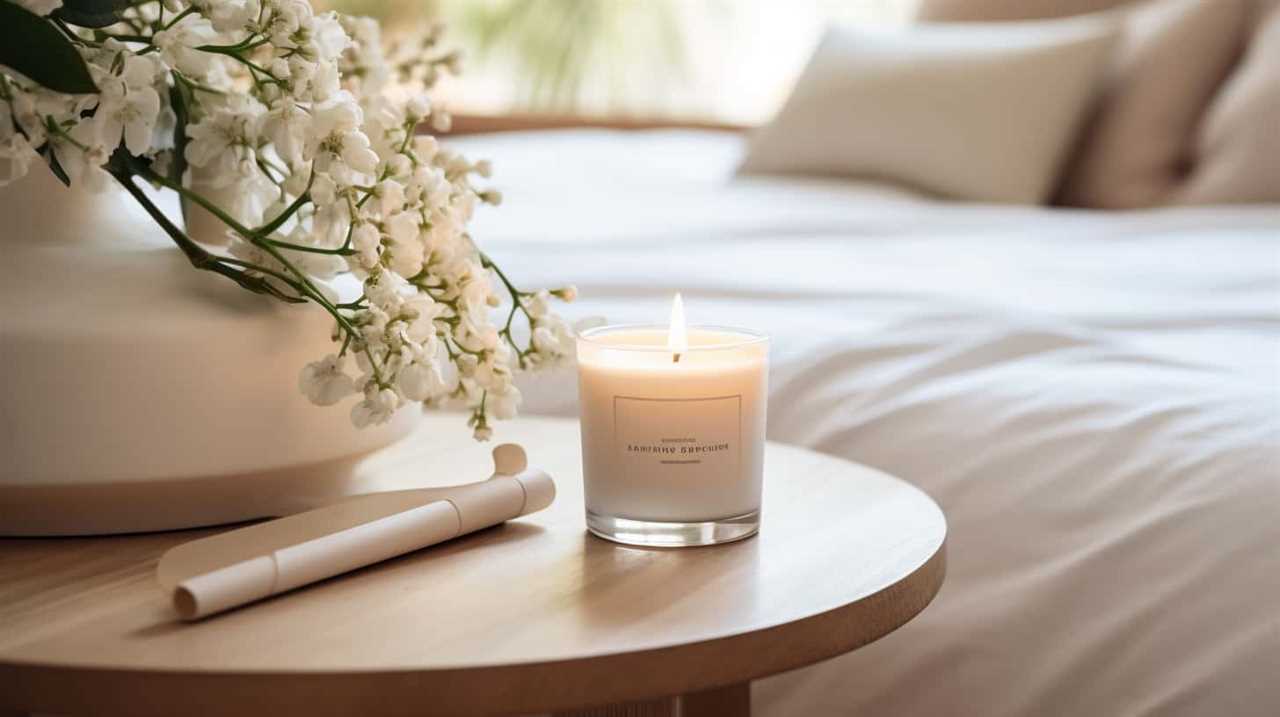
Can Certain Types of Candle Holders Affect the Burning Rate of a Candle?
Certain types of candle holders, such as metal or glass, can impact the burning rate of a candle. Additionally, the presence of a draft can also affect the speed at which a candle burns.
Does the Color of the Candle Affect Its Burning Speed?
When a candle burns slow, it can indicate various factors at play. The color of the candle may have an effect on its burning speed, as can the shape of the candle and the thickness of the wick.
Conclusion
In conclusion, when a candle burns slowly, it can be attributed to various factors such as the wax composition, wick length, ambient temperature, airflow, and candle size and shape. Scientifically speaking, these factors affect the rate at which the wax is consumed and the flame’s stability.
However, beyond the scientific explanations, a slow-burning candle can also hold symbolic interpretations. Just like the patience required to wait for a slow-burning candle, sometimes, the journey to our goals takes time and perseverance.
